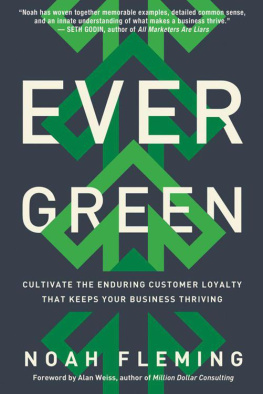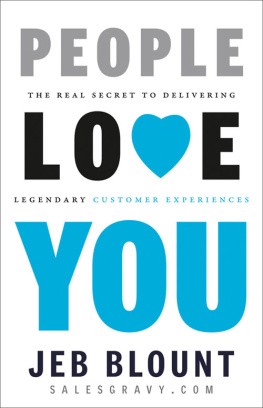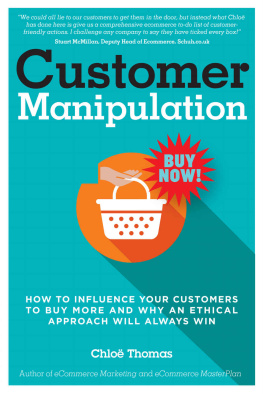The Customer Loyalty Loop
The Customer Loyalty Loop
The Science Behind Creating Great Experiences and Lasting Impressions
By Noah Fleming

Copyright 2017 by Noah Fleming
All rights reserved under the Pan-American and International Copyright Conventions. This book may not be reproduced, in whole or in part, in any form or by any means electronic or mechanical, including photocopying, recording, or by any information storage and retrieval system now known or hereafter invented, without written permission from the publisher, The Career Press.
THE CUSTOMER LOYALTY LOOP
EDITED BY PATRICIA KOT
TYPESET BY DIANA GHAZZAWI
Cover design by Howard Grossman/12E Design
Printed in the U.S.A.
To order this title, please call toll-free 1-800-CAREER-1 (NJ and Canada: 201-848-0310) to order using VISA or MasterCard, or for further information on books from Career Press.

The Career Press, Inc.
12 Parish Drive
Wayne, NJ 07470
www.careerpress.com
Library of Congress Cataloging-in-Publication Data
CIP Data Available Upon Request.
Acknowledgments
When you write a book, there are so many people on the sidelines cheering you on. As you get closer to the finish line, the cheering gets louder and more intense, the crowd roars, and then you cross the line. The first time I ran a half marathon, I felt like doing nothing for days. My feet ached because I embraced the then-popular idea of running barefoot. I realized shortly after the run that it wasnt such a great idea to try on the asphalt streets of downtown Toronto, and I paid for it for days. The point here is that there are so many people to thank during the process of writing a book and I cant thank you all individually, so consider this your collective high-five! Thank you all.
Of course, you have to thank your family. Theyre the ones who are there at the half-way mark with nourishment, brightly colored signs, and cheering the loudestGo, Daddy, Go! Heather, Avalon, and Ella, thank you. I love you all so much.
Thank you to my clients who have worked with me over the past few years! Cheers to our continued success!
In particular, thanks to my agent, Esmond Harmsworth, who continues to support my work and ideas. And I cant forget my incredibly talented cousin, Holly Barimah, who designed the fantastic-looking process visuals inside the book.
And thanks to the fine folks at Career Press for believing in this concept.
Contents
Introduction
Lets get this out of the way, right up front. Im not a psychologist or a scientist, and I dont play one on the Internet. Got it? Okay, good. Now that Ive cleared the air, and youre still here, lets talk about what this book is all about.
This book is all about the work I do with my clients and how it can help you grow your organization, increase your revenus and profits, and keep your customers happily spending their money with you.
And while I dont have a PhD in consumer psychology, what I do have is an enormous interest in helping my clients to bring their customers back, to get their customer to buy again, and to persuade them to buy even more after that. Thats what Im good at; thats what my clients would tell you Im good atmaybe even one of the best.
Now you could throw a stone in any city, click any random Internet link, and check your inbox on most mornings and youre almost guaranteed to find five experts promising to show you and your business how to get more new customers and close more business. The brutal reality is that not only is getting new customers fairly easy, its often quite harmful if done incorrectly.
The truth of almost every business is that creating, nurturing, and ultimately profiting from a long-term relationship with your customers is much harder, but also that much more valuable, and the process starts long before your prospects ever talk to someone at your company. Most companies dont really understand whats required to keep a customer, and most certainly dont understand that something like customer retention and loyalty starts long before you have a customer in the first place. Consider, for example, a recent survey that found that 72 percent of small businesses planned to allocate the majority of their marketing budgets to customer acquisition efforts and only 23 percent to customer retention efforts. And of those, 30 percent of them believe their customers do business with them on a regular basis, but theyre only guessing. You cant make this stuff up! Theyre assuming their customers are coming back, but they dont actually know if its true. This is the type of thing that surprises me. It shouldnt, but it still does.
That said, the research doesnt lie. And as I strongly argued in my first book, Evergreen, most companies I talk to are spending the bulk of their time chasing new customers at the expense of building deeper and more profitable relationships with their existing customers. Why? Please tell me why, Master Yoda.
Okay.
Quite frankly, its because its more fun. Its sexier, and the feedback is near instantaneous. When you tell someone that they need to focus on their existing customers more, youre just telling them something theyve heard a million times before. Theyve heard it at a million conferences. Theyve hired consultants and experts to speak at their organizations about servicing customers. Theyve read about it in dozens of other books. It must be important. Lets not forget the dusty, old chestnut that its five times more valuable to keep an existing customer than it is to get a new one! The reason its a big, dusty, old chestnut is that nobody has ever shown them how to make the existing customer five times more valuable. Dont you think thats a reasonable next question?
Theyve never been shown how to actually do the whole loyalty and retention thing in a systematic way thats measurable but also creates a demonstrable return on investmentsomething the folks in the C-Suite always need to see. Before I wrote Evergreen, there had never been a decent retention process to follow-up, maintain, nurture, and build relationships with our existing customers. Even the word relationship is one thats massively misunderstood in the business world. And in this book, Im going to give you something even more powerful. While this book is certainly not a sequel to Evergreen, it builds on the fact that youve made the decision to focus more on maximizing the value of the clients and customers youve worked so hard to get. Its all about the mind-set. We can concentrate on new clients. We can concentrate on existing customers. Or, we can do bothright.
So lets get back to that psychology and science thing. What could a customer-retention guy possibly teach his readers and clients about human buying behavior and how to influence itand more important, how the customers experience has such huge implications as to if the likelihood that the customer will ever do business with your company again? Well, it turns out, quite a lot! Since 2005, Ive worked with hundreds of companies and thousands of individuals. Ive read and studied everything I could get my hands on from the conventional theories of sales and marketing to the modern pop-psychology books, and loads of insanely fascinating neuromarketing material.
But so what...that means nothing.
There are a lot of neat ideas out there, but not nearly enough of them provide pragmatic, useful information for when the rubber meets the road and the customer finally walks through your doors, visits your website, picks up the phone to call you, or finally pulls out her credit card and clicks complete my order! Yeah, just like all those other guys, Ill talk about the latest study and tell you why its a neat insight, but what they dont show youand I willis how to actually use the stuff.
Next page








